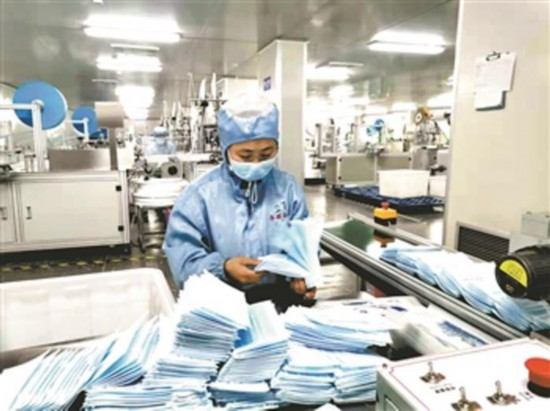

Chinese factories are currently in a race against time and going at full capacity to manufacture face masks. With every measure being taken to ramp up production capacity, the shortage is expected to be alleviated.

(Photo/Workers' Daily)
At present, there are nearly 500 workers working on two face mask production lines at Winner Medical, a leading manufacturer in Huanggang, central China’s Hubei province. They are working 24 hours a day on two daily shifts.
The production capacity of N95 respirators has increased from 36,000 to 45,000 per day, and the production capacity of surgical masks remained above 200,000 per day.
In addition to Hubei, other provinces in the country are also busy increasing their production capacity.
"There are two production lines and three shifts; we have manufactured 36,000 masks today," said Tang Yilin, chairman of Shengquan Group in Jinan, east China’s Shandong province.
During this year’s Spring Festival, the company has not only maintained normal production, but also worked overtime. “I realized there might be a shortage of masks, so I started purchasing raw materials urgently on Jan. 20 to arrange production during the Spring Festival," Tang said.
Shengquan Group has two automatic mask production lines that can produce N95 respirators. Normally, one production line with a dozen workers can produce 5,000 to 10,000 masks. During this year’s Spring Festival, two production lines were running at full capacity, with 60 to 70 workers on three shifts producing 30,000 to 35,000 masks per day.
Many enterprises across the country have returned to work urgently and are working overtime to catch up on production.
Data from the Ministry of Industry and Information Technology show that the maximum production capacity of face masks in China is more than 20 million per day.
Officials disclosed at a press conference on Feb. 2 that the actual production capacity of masks in China has recovered by 60 percent and daily production has exceeded 10 million.
According to the Department of Industry and Information Technology of Shandong province, Shandong is a major mask-producing province, accounting for 10 percent of the national production capacity, with a daily production of about 2 million.
In order to increase production, Shandong has addressed the needs for enterprise qualification and tapped potential open-source new capacity. For OEM enterprises that meet European, American or Japanese standards, Chinese labels will be affixed after filing for provincial sales.
At the same time, through the green channel for examination and approval and registration, the province has stepped up the issuance of pharmaceutical device registration certificates for enterprises, and a batch of masks and protective suits have been approved for the market.
With supply of face masks tight at home, many are turning to overseas sourcing. For instance, the China Overseas Development Association set up a working group to contact overseas resources.
"We immediately contacted the Shanghai Cooperation Organization, the Eurasian Economic Union, and so on, and further searched for supplies through them. At present, we have contacted companies in Germany, Russia, Ukraine, Poland, Kazakhstan and other countries that produce and market medical protective products," said He Zhenwei, Secretary General of the China Overseas Development Association.
Currently, in order to reduce the number of people queuing up to buy masks and ensure orderly market delivery, Shanghai, Hangzhou and other cities have successively implemented booking systems for purchase or registration for free distribution of masks.
Ms. Li, a Shanghai resident who has just received a purchase voucher for an appointment, said, "I can finally buy a mask."
"With the recent recovery of mask production capacity, this shortage is expected to ease gradually," an official at the Ministry of Industry and Information Technology said a few days ago.
 Fire brigade in Shanghai holds group wedding
Fire brigade in Shanghai holds group wedding Tourists enjoy ice sculptures in Datan Town, north China
Tourists enjoy ice sculptures in Datan Town, north China Sunset scenery of Dayan Pagoda in Xi'an
Sunset scenery of Dayan Pagoda in Xi'an Tourists have fun at scenic spot in Nanlong Town, NW China
Tourists have fun at scenic spot in Nanlong Town, NW China Harbin attracts tourists by making best use of ice in winter
Harbin attracts tourists by making best use of ice in winter In pics: FIS Alpine Ski Women's World Cup Slalom
In pics: FIS Alpine Ski Women's World Cup Slalom Black-necked cranes rest at reservoir in Lhunzhub County, Lhasa
Black-necked cranes rest at reservoir in Lhunzhub County, Lhasa China's FAST telescope will be available to foreign scientists in April
China's FAST telescope will be available to foreign scientists in April "She power" plays indispensable role in poverty alleviation
"She power" plays indispensable role in poverty alleviation Top 10 world news events of People's Daily in 2020
Top 10 world news events of People's Daily in 2020 Top 10 China news events of People's Daily in 2020
Top 10 China news events of People's Daily in 2020 Top 10 media buzzwords of 2020
Top 10 media buzzwords of 2020 Year-ender:10 major tourism stories of 2020
Year-ender:10 major tourism stories of 2020 No interference in Venezuelan issues
No interference in Venezuelan issues
 Biz prepares for trade spat
Biz prepares for trade spat
 Broadcasting Continent
Broadcasting Continent Australia wins Chinese CEOs as US loses
Australia wins Chinese CEOs as US loses